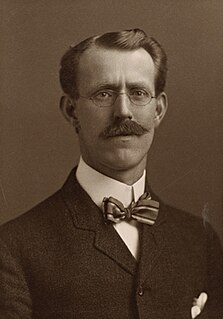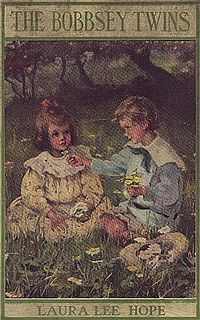
Nancy Drew is a fictional character who appears in several mystery book series as a teenage amateur sleuth. The books are ghostwritten by a number of authors and published under the collective pseudonym Carolyn Keene. Created by publisher Edward Stratemeyer as the female counterpart to his Hardy Boys series, the character first appeared in 1930 in the Nancy Drew Mystery Stories series, which lasted until 2003 and consists of 175 novels.

Mildred Augustine Wirt Benson was an American journalist and author of children's books. She wrote some of the earliest Nancy Drew mysteries and created the detective's adventurous personality. Benson wrote under the Stratemeyer Syndicate pen name, Carolyn Keene, from 1929 to 1947 and contributed to 23 of the first 30 Nancy Drew mysteries, which were bestsellers.
The Stratemeyer Syndicate was a publishing company that produced a number of mystery book series for children, including Nancy Drew, The Hardy Boys, the various Tom Swift series, the Bobbsey Twins, the Rover Boys, and others. They published and contracted the many pseudonymous authors doing the writing of the series from 1899 through 1987, when the syndicate partners sold the company to Simon & Schuster.
The Dana Girls was a series of young adult mystery novels produced by the Stratemeyer Syndicate. The title heroines, Jean and Louise Dana, are teenage sisters and amateur detectives who solve mysteries while at boarding school. The series was created in 1934 in an attempt to capitalize on the popularity of both the Nancy Drew Mystery Stories and the Hardy Boys series, but was less successful than either. The series was written by a number of ghostwriters and, despite going out-of-print twice, lasted from 1934 to 1979; the books have also been translated into a number of other languages. While subject to less critical attention than either Nancy Drew or the Hardy Boys, a number of critics have written about the series, most arguing that the Dana Girls' relative lack of success was due to the more dated nature of the series.

The Hardy Boys, brothers Frank and Joe Hardy, are fictional characters who appear in several mystery series for children and teens. The series revolves around teenagers who are amateur sleuths, solving cases that stumped their adult counterparts. The characters were created by American writer Edward Stratemeyer, the founder of book-packaging firm Stratemeyer Syndicate. The books themselves were written by several ghostwriters, most notably Leslie McFarlane, under the collective pseudonym Franklin W. Dixon.

Harriet Stratemeyer Adams was an American juvenile book packager, children's novelist, and publisher who was responsible for some 200 books over her literary career. She wrote the plot outlines for many books in the Nancy Drew series, using characters invented by her father, Edward Stratemeyer. Adams also oversaw other ghostwriters who wrote for these and many other series as a part of the Stratemeyer Syndicate, and rewrote many of the novels to update them starting in the late 1950s.

Howard Roger Garis was an American author, best known for a series of books that featured the character of Uncle Wiggily Longears, an engaging elderly rabbit. Many of his books were illustrated by Lansing Campbell. Garis and his wife, Lilian Garis, were possibly the most prolific children's authors of the early 20th century.

Edward L. Stratemeyer was an American publisher, writer of children's fiction, and founder of the Stratemeyer Syndicate. He was one of the most prolific writers in the world, producing in excess of 1,300 books himself, selling in excess of 500 million copies. He also created many well-known fictional book series for juveniles, including The Rover Boys, The Bobbsey Twins, Tom Swift, The Hardy Boys, and Nancy Drew series, many of which sold millions of copies and are still in publication today. On Stratemeyer's legacy, Fortune wrote: "As oil had its Rockefeller, literature had its Stratemeyer."

The Bobbsey Twins are the principal characters of what was, for 75 years, the Stratemeyer Syndicate's longest-running series of American children's novels, written under the pseudonym Laura Lee Hope. The first of 72 books was published in 1904, the last in 1979, with a separate series of 30 books published from 1987 through 1992. The books related the adventures of the children of the upper-middle-class Bobbsey family, which included two sets of fraternal twins: Nan and Bert, who were twelve years old, and Flossie and Freddie, who were six.
Charles Leslie McFarlane was a Canadian journalist, novelist, screenwriter, and filmmaker, who is most famous for ghostwriting many of the early books in the very successful Hardy Boys series, using the pseudonym Franklin W. Dixon.

The House On The Cliff is the second book in the original The Hardy Boys Mystery Stories published by Grosset & Dunlap. The book ranks 72nd on the Publishers Weekly's All-Time Bestselling Children's Book List in the United States with 1,712,433 copies sold as of 2001. This book is one of the "Original 10" Hardy Boys books and is an excellent example of the writing style used by the Stratemeyer Syndicate's writers. This style influenced many other "youth adventure series" books that the Stratemeyer Syndicate also published, including the Nancy Drew series, the Tom Swift adventure series, the Bobbsey Twins and other lesser known series. All of them used a unique writing style that made them very recognizable as Stratemeyer product.
Andrew E. Svenson was an American children's author, publisher, and partner in the Stratemeyer Syndicate. Under a variety of pseudonyms, many shared with other authors, Svenson authored or coauthored more than 70 books for children, including books for the Hardy Boys, Bobbsey Twins, Tom Swift, and Honey Bunch series. He wrote the series The Happy Hollisters using the pseudonym Jerry West and The Tolliver Family as Alan Stone.

Walter Karig was a prolific author, who served as a US naval captain. Karig wrote a number of works on Allied naval operations during World War II. He also wrote scripts for the television series Victory at Sea. Besides his works on naval history, Karig was a novelist, publishing under his own name, and a journalist.

Lilian C. Garis , born Lilian C. McNamara was an American author who wrote hundreds of books of juvenile fiction between around 1915 and the early 1940s. Prior to this, she was the first female reporter for the Newark Evening News in New Jersey. Garis and her husband, Howard R. Garis, were possibly the most prolific children's authors of the early 20th century.
The Nancy Drew Mystery Stories is the long-running "main" Nancy Drew series, which was published under the pseudonym Carolyn Keene. There are 175 novels — plus 34 revised stories — that were published between 1930 and 2003 under the banner; Grosset & Dunlap published the first 56, and 34 revised stories, while Simon & Schuster published the series beginning with volume 57.
The Betty Gordon books were an early Stratemeyer Syndicate series, published under the pseudonym Alice B. Emerson.
The Honey Bunch series of books were part of the Stratemeyer Syndicate's production of 20th century children's books featuring adventurous youngsters, which included the series Nancy Drew, the Hardy Boys and the Bobbsey Twins. This series was written under the pseudonym Helen Louise Thorndyke, and published for most of its duration by Grosset & Dunlap. The series began in 1923 and chronicled a young girl named Honey Bunch on her various trips and adventures. Along with Laura Lee Hope's series Bunny Brown and His Sister Sue, it was one of their most famous series for younger children.
Josephine Lawrence (1889–1978) was an American novelist and journalist. Her works chronicled the lives of common people, with stories often filled with a large cast of bustling characters, emphasizing the everyday lives of children and the elderly.

A. L. Burt was a New York-based book publishing house from 1883 until 1937. It was founded by Albert Levi Burt, a forty year old from Massachusetts who had come to recognize the demand for inexpensive reference works while working as a traveling salesman. The company began by reprinting home reference works and reprints of popular and classic fiction, before expanding into the field of children's works, particularly series books.











